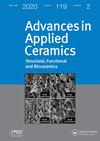3d打印多孔氧化铝膜涂覆亲水性改性二氧化钛颗粒大通量油/水分离
IF 1.6
4区 材料科学
Q3 MATERIALS SCIENCE, CERAMICS
引用次数: 0
摘要
解决水中油类污染的可行材料是可实现油水分离的超润湿表面。根据杨氏方程,疏水/亲油材料理论上易于实现,具有广泛的应用范围。然而,疏水/亲油膜对油密度低于水的混合物分离效果较差。因此,为了优化油水分离性能,本研究将亲水改性二氧化钛颗粒引入到3D打印技术制备的新型多孔超亲水/疏油基板中。正十六烷与膜表面的接触角约为130°,为疏油表面。0.7 mm厚的疏油膜的油水分离效率可达98%以上,渗透通量可达11191 L m−2 h−1,表明所制备的膜可用于高通量油水分离。本研究为利用3D打印技术制备油水分离材料提供了一种高效、简单、可靠的方法,在学术界和工业界可能具有更广泛的意义。关键词:3D打印;超亲水/疏油膜;油水分离;亲水改性;披露声明作者未报告潜在的利益冲突。竞争利益声明作者声明,他们没有已知的竞争经济利益或个人关系,可能会影响本文所报道的工作。经费资助:中央高校基本科研业务费专项资金[批准号:3102019PJ008和3102018JCC002];国家重点研发计划项目[批准号2021YFB3701500];国家自然科学基金项目[批准号52072306]。本文章由计算机程序翻译,如有差异,请以英文原文为准。
3D-printed porous Al 2 O 3 membrane coated with hydrophilic modified titanium dioxide particles for large-flux oil/water separation
ABSTRACTA viable material to address oil pollution in water is the super wetting surface, which is accessible to realise the separation of oil and water. According to Young’s equation, hydrophobic/oleophilic materials are theoretically simple to realise and have a wide range of applications. The hydrophobic/oleophilic membrane, however, has a poor separating effect on the mixture in which the oil has a lower density than water. Hence, to optimise the oil/water separation performance, hydrophilic modified titanium dioxide particles were introduced to a novel porous superhydrophilic/oleophobic substrate fabricated by 3D printing technology in this work. The contact angle of n-hexadecane on the membrane surface was about 130°, which was an oleophobic surface. The oil/water separation efficiency of the 0.7 mm thick oleophobic membrane was over 98% and the penetration flux was up to 11,191 L m−2 h−1, indicating that the membranes prepared in this work might be used in high-flux oil/water separation applications. This study provides an efficient, simple, and reliable method for preparing oil/water separation materials with 3D printing technology, and may have broader significance among the academic and industry communities.KEYWORDS: 3D printingsuperhydrophilic/oleophobic membraneoil/water separationhydrophilic modificationporous structure AcknowledgementsWe would like to thank the Analytical & Testing Center of Northwestern Polytechnical University for SEM and TEM.Disclosure statementNo potential conflict of interest was reported by the author(s).Declaration of competing interestThe authors declare that they have no known competing financial interests or personal relations that could have appeared to influence the work reported in this paper.Additional informationFundingThis work was financially supported by the Fundamental Research Funds for the Central Universities [grant number 3102019PJ008 and 3102018JCC002]; National Key Research and Development Program of China [grant number 2021YFB3701500]; National Natural Science Foundation of China [grant number 52072306].
求助全文
通过发布文献求助,成功后即可免费获取论文全文。
去求助
来源期刊

Advances in Applied Ceramics
工程技术-材料科学:硅酸盐
CiteScore
4.40
自引率
4.50%
发文量
17
审稿时长
5.2 months
期刊介绍:
Advances in Applied Ceramics: Structural, Functional and Bioceramics provides international coverage of high-quality research on functional ceramics, engineering ceramics and bioceramics.
 求助内容:
求助内容: 应助结果提醒方式:
应助结果提醒方式:


